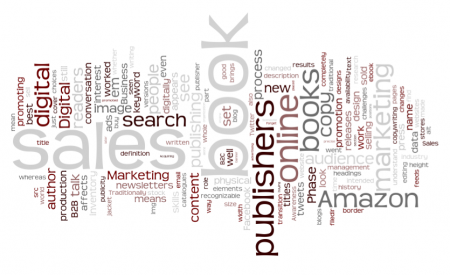How do digital sales affect how books are published and promoted?

My day job here at Boxcar Marketing is about helping companies understand what they can do on the web to promote themselves, to build their customer base and to interact with their customers effectively.
A lot of that work has to do with words. Writing and editing content for webpages, press releases, email newsletters, blog posts, tweets, surveys, downloadable PDFs, search ads, banner ads, and Facebook event invitations, to name a few.
When I worked in the book publishing industry (1996 to 2006), these items (if they existed) were part of the later phases of the publishing cycle. The author wrote the book, the agent sold the book to a publisher, the editor and author worked on refining the book, it went to production, sales and marketing started talking about the book, the book went to the printer, the sales reps sold the book to stores, the publicists pitched the book to reviewers, printers shipped the books to stores, the reviews came out in newspapers and magazines, the book appeared on book shelves, marketing and promotion kicked in, sales occurred, publicity continued for 3 months, more sales were made and/or unsold copies were returned to the publisher. Wash and repeat.
Digital sales changed the publishing world, not just in how we write online content, but how we sell online.
In the industry, we talk about the impact of Amazon discounts, we talk about price points for physical vs. ebook, we fret over making those ebooks,and we talk about DRM. But few people talk about how digital sales has affected every facet of the publishing process.
As an online marketing strategist, this is what I see.
Editorial Phase
Knowledge acquisition and audience interest.
What happens at the editorial stage positions the book through the entire sales process. The keyword choices made for the book title, subtitle, description and author bio determine whether readers will be able to easily find that book when searching Amazon, and search engines such as Google.
Acquiring search engine marketing skills has served many publishers well.
Production Phase
Branding, layout and design.
Digital sales brings a whole new set of requirements to the production phase. Just the cover design alone presents new challenges. For physical books, there’s the font size, colour choices, imagery, and how to make all the required elements look good for books face out on the shelf, spine out, placed on a table, seen close up or recognizable from afar.
Digital sales brings us thumbnail versions of the book for display on Amazon and other websites, plus icons for Facebook and Twitter, and black and white versions for ebook readers.
Have a look at Amazon (find the book section). What covers are distinct? Which stand out? Why?
Compare this set of designs:

To this set of designs:

You’ll see that high contrast and large fonts work best, so that, when reduced, the cover is still recognizable and legible.
Sales Phase
Awareness and availability to buy.
Traditionally publishers saw themselves in a B2B role. Business to Business.
Publishers worked with teachers, librarians, media and booksellers. The marketing model was built around educating that group of people so that they could go out and recommend or sell the books to readers.
Digital sales put publishers in a B2C role. Business to Consumer.
Publisher websites, blogs, Facebook pages, and Twitter feeds all contribute to the online conversation about books and authors. This conversation between publishers and book readers is really important, even for publishers who are not selling books directly from their website.
By fostering conversation early and showing interest in a new book, the sales folks are in a better position to negotiate with their B2B partners.
Booksellers such as Amazon stock almost everything, but they decide through advertising dollars, partnerships and mathematical algorithms what books will appear in their newsletters, on the homepage or browse pages, and even what appears in the search results and the order in which titles are displayed in those results.
Amazon is looking for titles that can break away from the pack. These are the ones they are interested in promoting because the audience size and interest is clear. (You can bet that they’re reviewing sales history, search history, keyword research, and PPC conversions.)
Sales & Returns: Inventory
A subset of sales is inventory management, which is completely changed by digital sales. Forget about the challenges of digital downloads, let’s just look at physical inventory sold digitally.
Bibliographic data (all the info you see about a book online) is fed to retailers through xml feeds that contain this data. Someone needs to manage all of that in an incredibly precise way. Information on title, author, publication date, and inventory stock levels affects what people see online. The data is traded daily, even hourly, to ensure that what you see online is the best reflection of availability and shipping time.
Making a mistake here could mean that your book appears on Amazon with a delivery time of 3-5 weeks. Imagine how that affects the impulse buy!
Marketing & Publicity Phase
Awareness, outreach, and engagement.
Marketing is the process of promoting and selling a product or service. This traditional definition is true. But what does promoting and selling mean in a digital world? A clearer definition might be:
Marketing is any way that you engage with people to generate exposure, opportunity and sales.
In the case of marketing and publicity, this includes writing content that is remarkable, unique and newsworthy. And it likely means you’re publishing that material in the form of blogs, press releases, newsletters, tweets, and ads.
Back to keyword research, right?
If people are buying digitally, it means they are also discovering digitally. This changes what keywords publishers choose to use in blog headings, press releases, newsletter articles, tweets, twitter hashtags and on-page optimization elements (filenames, page titles, headings, text).
Behind the scenes, this also affects the sales materials publishers create, such as catalogues. Print catalogues were (and still are) produced each season to profile upcoming books. The book descriptions used in the catalogue are typically the same description that appears on Amazon and the publisher’s website.
But is the B2B copy the best copy for a B2C audience?
Traditionally sales copy is written for the bookseller whereas jacket copy is written for the book reader. Both are meant to entice, but the intended audience is different.
Even publishers who upload jacket copy should consider whether copy intended for a print audience translates well to an online reading experience. Large blocks of prose don’t work well online whereas shorter sentences, bulleted lists, highlight colors and bolded text help online readers scan and understand information quickly.
Digital sales should have completely altered this copywriting process, but publishers are still in transition.
This transition period means that in addition to needing good writing, editing, production, promotion and sales skills, digital sales are forcing publishers to acquire email marketing, search marketing, content creation and asset management skills that are reminiscent of traditional approaches yet have a whole new set of considerations.
What changes have you seen to copywriting, book design or promotion as a result of digital sales?


